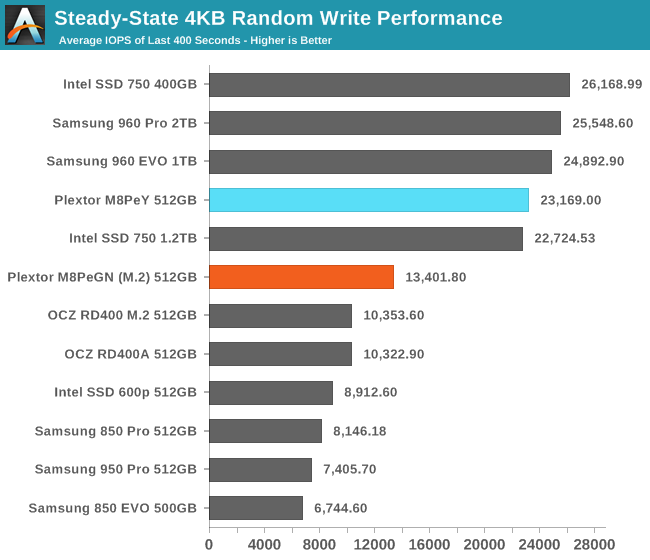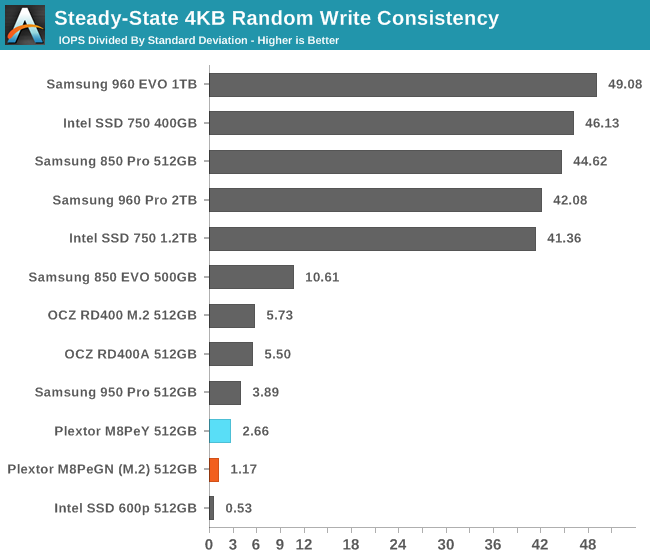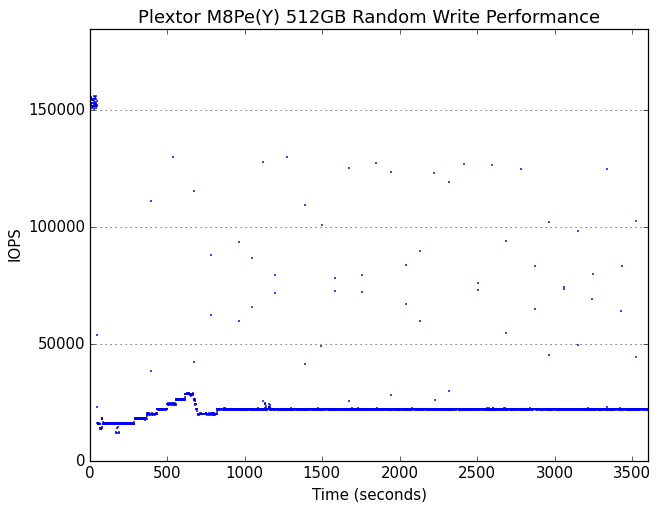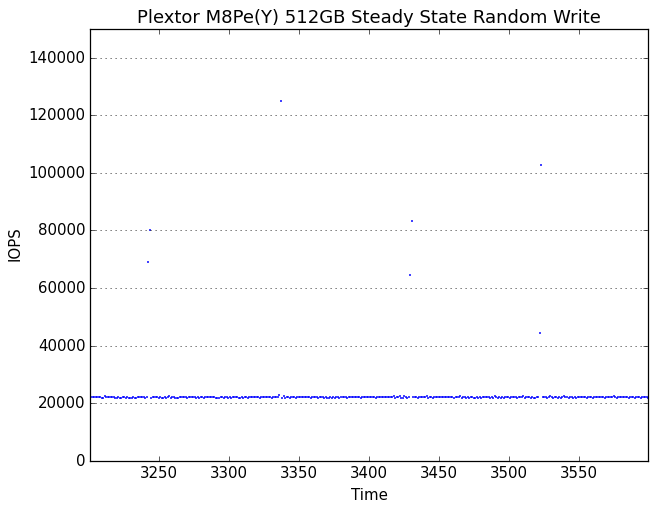The Plextor M8Pe (512GB) SSD Review
by Billy Tallis on December 14, 2016 9:00 AM ESTPerformance Consistency
Our performance consistency test explores the extent to which a drive can reliably sustain performance during a long-duration random write test. Specifications for consumer drives typically list peak performance numbers only attainable in ideal conditions. The performance in a worst-case scenario can be drastically different as over the course of a long test drives can run out of spare area, have to start performing garbage collection, and sometimes even reach power or thermal limits.
In addition to an overall decline in performance, a long test can show patterns in how performance varies on shorter timescales. Some drives will exhibit very little variance in performance from second to second, while others will show massive drops in performance during each garbage collection cycle but otherwise maintain good performance, and others show constantly wide variance. If a drive periodically slows to hard drive levels of performance, it may feel slow to use even if its overall average performance is very high.
To maximally stress the drive's controller and force it to perform garbage collection and wear leveling, this test conducts 4kB random writes with a queue depth of 32. The drive is filled before the start of the test, and the test duration is one hour. Any spare area will be exhausted early in the test and by the end of the hour even the largest drives with the most overprovisioning will have reached a steady state. We use the last 400 seconds of the test to score the drive both on steady-state average writes per second and on its performance divided by the standard deviation.

The heatsink makes a huge difference in the sustained random write performance of the M8Pe. With the heatsink, the M8Pe is competitive with the Intel 750 and the Samsung 960 Pro and EVO. Without the heatsink, the M8Pe is slower by almost 10k IOPS, but still above average for consumer SSDs, including some of the NVMe competition.

The M8Pe's consistency scores are quite low, indicating that it lacks the tight regulation of Samsung and Intel's best drives that have similar average performance.
 |
|||||||||
| Default | |||||||||
| 25% Over-Provisioning | |||||||||
The second by second performance plot reveals that the apparently low consistency is on the M8PeY due entirely to occasional outliers of extremely high performance; most of the time the M8PeY is operating at a very consistent ~22k IOPS, and none of the outliers fall below that level. The M8PeGN without a heatsink or heatspreader suffers from frequent periods of thermal throttling and slightly lower performance when not throttled. The lower performance also causes the M8PeGN to take slightly longer to reach steady state.
 |
|||||||||
| Default | |||||||||
| 25% Over-Provisioning | |||||||||
With a heatsink, the M8Pe's steady state hovers around 22k IOPS, but without the heatsink it alternates between 18k IOPS and a thermally throttled 2400 IOPS. Fortunately, it spends more time in the high-performance state than the low performance state, and there are still a few of the extreme outliers above 100k IOPS.
The M8Pe responds very well to extra overprovisioning. The variability is increased slightly, but the performance with the heatsink jumps to 90-100k IOPS sustained. Without a heatsink, the steady state only increases to 60-65k IOPS, but the drive spends much less time thermally throttled and the performance in that state increases to about 6800 IOPS. It's no surprise that the Marvell 88SS1093 controller has been a popular choice for enterprise M.2 PCIe SSDs.










64 Comments
View All Comments
MrSpadge - Wednesday, December 14, 2016 - link
Considering your ADATA is quite small at just 1 GB, these will be a noticeable upgrade. Starting from a 1 TB drive, though, will likely not be noticeable (unless you're running significantly I/O limited workloads).Ratman6161 - Wednesday, December 14, 2016 - link
Assuming you meant 1TB rather than 1 GB. Can the majority of humans tell the difference? I can't speak to what the majority can tell but I can state my personal experience. My main system drive is currently a 250 GB 850 EVO. I've also had an opportunity to (though briefly) to use a system with a 950 Pro in it. For anything that I personally do, no, I could not tell the difference. Of course I don't do anything particularly storage intensive either. I'm most concerned with boot up time and how fast programs open, etc.To me, given pricing as it exists today, there are only really three drives mentioned that I would even think about. Assuming you need an m.2 form factor (which I currently don't so will stick with my 850 EVO) 960 Pro if you want the best performance available, 960 EVO if you want great upscale performance at a reasonable price, and the Intel 600 P if you don't need great performance but do need the M.2 form factor. But if the prices change it may well be possible to just buy the cheapest in the particular performance class you want.
sinPiEqualsZero - Wednesday, December 14, 2016 - link
Thanks to both of you. I did mean 1 TB, my bad. I have one of the DAN cases and will be building it out in Jan/Feb, that's why I asked. Looks like I'm sticking with SATA unless prices come down. Mayyyyybe the 960 EVO.Bruce427 - Friday, December 16, 2016 - link
** [get] the Intel 600 P if you don't need great performance but do need the M.2 form factor. **Currently, the MyDigital BPX NVMe drives will significantly outperform the 600Ps, and for less money.
They also use MLC flash and have a full 5 year warranty.
I have several 950 Pros. I recently bought/installed a 240GB BPX for benchmarking/testing and at $107.85 (what I paid) it's a great little drive.
Death666Angel - Sunday, December 18, 2016 - link
MyDigital doesn't have European retailers it seems? At least nothing but one listing in Germany for a BP4. :/ddriver - Saturday, December 17, 2016 - link
No, 99% of the use cases won't show tangible improvement. SATA SSDs are already fast enough to eliminate storage as a bottleneck. You may have TB\sec and it will still not make a difference if the bottleneck is somewhere else.peterfares - Wednesday, December 14, 2016 - link
Why is there a power connector on top?Billy Tallis - Wednesday, December 14, 2016 - link
I think it's just an alternate power delivery path for situations where the PCIe slot doesn't provide enough. I didn't bother using it, since I was measuring power consumption through the PCIe slot.XabanakFanatik - Wednesday, December 14, 2016 - link
When are you going to redo new drives like the 960 Pro/Evo and RD400 with the angelbird wings PX1 so we can see how and if oerformance improves with a heatsink?Last year AT had redone benches from the 950 pro this way.
Billy Tallis - Wednesday, December 14, 2016 - link
At the moment, I'm more concerned with putting together an updated test suite for 2017. Once that's ready and everything's been re-tested, I'll go back and test the 960s with a heatsink. It'll probably be February, and probably won't be worth an article of its own.We already have the RD400A results in Bench, and the one thermal pad behind the controller that it uses was enough to eliminate thermal throttling (with one possible exception).